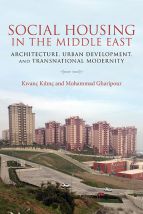Social Housing in the Middle East: Architecture, Urban Development, and Transnational Modernity

This book responds to a perceived gap in scholarship on housing styles in Middle Eastern cities. It identifies two contemporary trends that have resulted from insufficient housing, and insufficient government interesting in housing, in the Middle East: the rise of informal settlements and self-built homes; and the role of small-scale contractors. Persistent conflict has also given rise to sprawling refugee camps. Social Housing in the Middle East attempts to incorporate all these kinds of spaces for low- and middle-income urbanites – as opposed to the large, flashy housing projects, targeting the affluent, that have been developed by neoliberal networks.
The book brings together analyses of cities in Jordan, Iran, Turkey, Egypt, Tunisia, Israel, Cyprus and Kuwait. Many chapters focus on colonial echoes in older versions of social housing, such as the subsidized workers’ housing that grew along with post-war urbanization in Cypriot cities. Another common theme is public housing as a way of expressing the legitimacy of the state – most starkly in Israel – or a particular branch of politics – as with Islamist political parties in Turkey.
One interesting strand is the gendering of certain public housing spaces. For instance, in the 1980s, Kuwait’s Sabah al-Salem Housing Project became limited to unemployed widows and divorcees with children, after failing to take off with the male-headed families for which it was intended. The housing complex was isolated and located far from the economic opportunities in the centre of Sabah al-Salem, and households headed by men were reluctant to live in apartments. In author Mae al-Ansari’s analysis, these factors reinforced the marginality of the women living in cut-off and increasingly dilapidated housing, who already had to contend with the stigma of their marital status.
In the 1980s and 1990s, the Israeli government made some missteps when considering gender sensitivities in its planned housing for ultra-Orthodox communities. In one, the position of the bathroom door in the bedroom made it impossible for a wife and a husband to have two separate beds. In another, the architects designed a living room door that would allow the husband to use the living room as a study. However, this “worked against the main purpose of the ultra-Orthodox living room: accommodating Shabbat dinners for the extended family” (pages 253–4). Ultimately, members of the Beitar Illit community began to work with architects to design facilities that they found more appropriate, such as large homes that could fit expanding families. (In contrast, the lack of a residents’ association in Sabah al-Salem limited the capacity of the women to generate change.)
Throughout Social Housing in the Middle East, there’s a concern with groups that are too often overlooked by people with decision-making power: migrants building the UAE’s gleaming towers, people living and working informally in Turkey, squatters in Iran. While social housing is generally intended for some of the least privileged members of society, a lingering question is how well this housing actually accommodates their needs.
Further reading:
Allweil, Yael (2013), “Surprising alliances for dwelling and citizenship: Palestinian-Israeli participation in the mass housing protests of summer 2011”, International Journal of Islamic Architecture Vol 2, No 1, pages 41–75, available at https://www.researchgate.net/publication/262566388_Surprising_Alliances_....
Daher, Rami Farouk (2013), “Neoliberal urban transformations in the Arab city: meta-narratives, urban disparities and the emergence of consumerist utopias and geographies of inequalities in Amman”, Urban Environment Vol 7, available at https://journals.openedition.org/eue/411.
Richmond, Pattie (1997), “From tenants to owners: experiences with a revolving fund for social housing”, Environment and Urbanization Vol 9, No 2, pages 119–140, available at https://journals.sagepub.com/doi/pdf/10.1177/095624789700900203.
Book note prepared by Christine Ro
Search the Book notes database
Our Book notes database contains details and summaries of all the publications included in Book notes since 1993 - with details on how to obtain/download.
Use the search form above, or visit the Book notes landing page for more options and latest content.
For a searchable database for papers in Environment and Urbanization, go to http://eau.sagepub.com/

